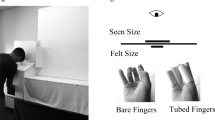Abstract
We often handle an object with both of our hands. The information from the two hands has to be combined to arrive at a single percept of the object. Research on multi-sensory perception has shown that redundant information between the senses is integrated such that the combined percept is more precise than either of the two individual inputs. However, while bimanual information can be redundant, it is not necessarily the case because both hands are usually touching different parts of the same object. To investigate whether there is a difference in precision of unimanual and bimanual information, we asked participants to discriminate stiffness unimanually as well as bimanually. Our results clearly show that bimanual perception of stiffness was more precise than unimanual perception. The precision of the bimanual percept was in agreement with the precision predicted from combining the two unimanual inputs in a statistical optimal fashion.
Access this chapter
Tax calculation will be finalised at checkout
Purchases are for personal use only
Preview
Unable to display preview. Download preview PDF.
Similar content being viewed by others
References
Giachritsis, C.D., Ferre, M., Barrio, J., Wing, A.M.: Unimanual and bimanual weight perception of virtual objects with a new multi-finger haptic interface. Brain Research Bulletin 85(5, SI), 271–275 (2011)
van der Horst, B.J., Willebrands, W.P., Kappers, A.M.L.: Transfer of the curvature aftereffect in dynamic touch. Neuropsychologia 46(12), 2966–2972 (2008)
van der Horst, B.J., Duijndam, M.J.A., Ketels, M.F.M., Wilbers, M.T.J.M., Zwijsen, S.A., Kappers, A.M.L.: Intramanual and intermanual transfer of the curvature aftereffect. Experimental Brain Research 187(3), 491–496 (2008)
Ernst, M., Bulthoff, H.: Merging the senses into a robust percept. Trends in Cognitive Sciences 8(4), 162–169 (2004)
Ernst, M.O., Banks, M.S.: Humans integrate visual and haptic information in a statistically optimal fashion. Nature 415, 429–433 (2002)
Helbig, H.B., Ernst, M.O.: Optimal integration of shape information from vision and touch. Experimental Brain Research 179(4), 595–606 (2007)
Ernst, M.O., Lange, C., Newell, F.N.: Multisensory recognition of actively explored objects. Canadian Journal of Experimental Psychology 61, 242–253 (2007)
Alais, D., Burr, D.: The ventriloquist effect results from near-optimal bimodal integration. Current Biology 14(3), 257–262 (2004)
van Beers, R., Sittig, A., van der Gon, J.: Integration of proprioceptive and visual position-information: An experimentally supported model. Journal of Neurophysiology 81(3), 1355–1364 (1999)
Slutsky, D., Recanzone, G.: Temporal and spatial dependency of the ventriloquism effect. NeuroReport 12(1), 7–10 (2001)
Helbig, H.B., Ernst, M.: Knowledge about a common source can promote visual-haptic integration. Perception 36(10), 1523–1533 (2007)
Wichmann, F., Hill, N.: The psychometric function: I. Fitting, sampling, and goodness of fit. Perception & Psychophysics 63(8), 1293–1313 (2001)
Squeri, V., Sciutti, A., Gori, M., Masia, L., Sandini, G., Konczak, J.: Two hands, one perception: how bimanual haptic information is combined by the brain. Journal of Neurophysiology 107(2), 544–550 (2012)
Author information
Authors and Affiliations
Editor information
Editors and Affiliations
Rights and permissions
Copyright information
© 2012 Springer-Verlag Berlin Heidelberg
About this paper
Cite this paper
Plaisier, M.A., Ernst, M.O. (2012). Two Hands Perceive Better Than One. In: Isokoski, P., Springare, J. (eds) Haptics: Perception, Devices, Mobility, and Communication. EuroHaptics 2012. Lecture Notes in Computer Science, vol 7283. Springer, Berlin, Heidelberg. https://doi.org/10.1007/978-3-642-31404-9_22
Download citation
DOI: https://doi.org/10.1007/978-3-642-31404-9_22
Publisher Name: Springer, Berlin, Heidelberg
Print ISBN: 978-3-642-31403-2
Online ISBN: 978-3-642-31404-9
eBook Packages: Computer ScienceComputer Science (R0)




